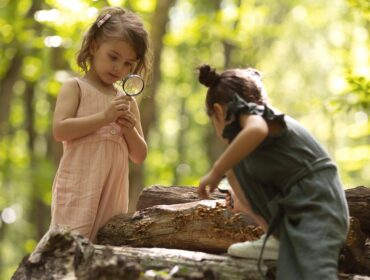Turning Trails into Treasure Hunts
Hiking is one of the best ways to get kids outdoors, but not every child is immediately excited about walking miles through the woods. The key to keeping their energy high and their curiosity engaged? Turn the hike into a game. A scavenger hunt transforms a regular nature walk into an adventure packed with discovery, learning, and laughs.
In this blog, we’ll share scavenger hunt ideas that blend creativity, nature education, and fun – all designed to keep children motivated on the trail. Whether you’re planning a short forest walk or a full-day family hike, these ideas will turn the great outdoors into your kids’ favorite playground.
Why Scavenger Hunts Work
Scavenger hunts capture kids’ attention by offering them a clear objective: find and identify specific items along the trail. This not only keeps them moving forward but also encourages them to observe their surroundings more closely.
Here are some benefits of using scavenger hunts on hikes:
-
Reduces whining and boredom
-
Teaches observation and curiosity
-
Encourages teamwork
-
Builds appreciation for nature
-
Incorporates sensory and critical thinking skills
Now, let’s dive into themed scavenger hunt ideas and how to tailor them for different age groups.
1. Classic Nature Item Hunt
Perfect for Ages 4-10
This traditional version is ideal for beginners. Prepare a checklist of items your child might encounter on the trail. You can use images for younger kids or words for older readers.
Sample List:
-
A pinecone
-
A yellow flower
-
A feather
-
A smooth rock
-
Animal tracks
-
Something that smells good
-
A leaf with jagged edges
To make it interactive, laminate the list and bring a dry-erase marker. Or, turn it into a bingo sheet!
2. Color Hunt
Perfect for Preschoolers and Toddlers
Instead of looking for specific objects, kids find things that match colors. This simple concept builds visual awareness and is great for little ones still learning their colors.
Instructions:
Bring a color wheel or colored cards. Kids match each to something in nature: a red berry, a green fern, a blue sky, a brown mushroom, etc.
Pro Tip: Use a rainbow-themed printable card for added excitement.
3. Texture Touch Scavenger Hunt
Perfect for Sensory Learners (Ages 5-12)
Encourage your child to feel their way through the trail. This version uses textures rather than objects.
What to Hunt:
-
Something rough (tree bark)
-
Something soft (moss)
-
Something smooth (river pebble)
-
Something bumpy (acorn cap)
-
Something cold (stream water or rock in shade)
This hunt sharpens their tactile sense and brings a whole new layer to trail experiences.
4. Alphabet Nature Hunt
Ideal for Elementary Schoolers
Challenge your kids to find one item from nature for each letter of the alphabet. You don’t have to find all 26 letters, but aim for as many as possible.
Example:
-
A = ant
-
B = bark
-
C = cloud
-
D = dragonfly
-
E = evergreen
To make it a team game, split into two groups and see who can complete the most letters before lunch!
5. Wildlife Detective
Best for Kids Ages 8-13
This version leans into animal tracking and teaches basic nature skills. Provide kids with a small field guide or chart that includes:
-
Common birds
-
Animal tracks
-
Animal calls
-
Nests or burrows
-
Insect sightings
Let kids use binoculars and notepads to log what they see. Extra points for mimicking bird calls or photographing bugs!
6. Senses Challenge Hunt
Engaging for All Ages
This scavenger hunt is all about mindfulness and observation using all five senses. Create a card with prompts like:
-
Hear a bird chirping
-
Smell a flower
-
Feel a cool breeze
-
See something moving
-
Taste something (ONLY if pre-approved like berries from an adult)
It’s a great tool to introduce nature-based mindfulness while making it a fun challenge.
7. Story Builder Hunt
Creative Twist for Ages 7-14
Give kids a scavenger list of objects, but instead of just finding them, they must create a story about them by the end of the hike. For example:
-
A crooked stick
-
An oddly shaped rock
-
A butterfly
-
An abandoned bird nest
Once you reach your snack or picnic spot, let kids share the stories they’ve imagined using the items found.
8. Trash Treasure Hunt
Perfect for Ages 6+ (and Eco-Conscious Families)
Turn your hike into a trail-cleaning mission. Challenge kids to collect litter (safely with gloves or tongs) and treat it like a “treasure.”
Offer rewards for categories like:
-
Most plastic picked
-
Weirdest find
-
Best before-and-after trail spot
This teaches Leave No Trace ethics while gamifying stewardship of the outdoors.
9. Seasonal Scavenger Hunts
Each season has its own unique highlights. Adapt your scavenger hunt to reflect the time of year.
Spring:
-
Blooming flowers
-
Buzzing bees
-
Frog sounds
-
Fresh green leaves
Summer:
-
Butterflies
-
Wild berries
-
Mushroom rings
-
Lush canopy shade
Autumn:
-
Colorful leaves
-
Falling acorns
-
Squirrel activity
-
Crunchy trails
Winter:
-
Bare branches
-
Animal prints in snow or mud
-
Icicles
-
Evergreen trees
Using season-specific lists keeps things fresh and exciting throughout the year.
10. Photo Safari Scavenger Hunt
Great for Ages 10-Teen
If your kids love tech, lean into it. Let them use a phone or camera to capture photos instead of collecting items.
Photo Targets:
-
A reflection in water
-
An insect close-up
-
The tallest tree
-
Something red
-
A funny-shaped rock
This teaches basic photography and sharpens attention to small details. Bonus: you’ll end the day with a digital scrapbook of the hike.
Tips for a Successful Scavenger Hunt
-
Prep Your Gear:
Bring clipboards, printed cards, pencils, and a small bag to carry collected items (if allowed). -
Set Clear Rules:
No disturbing wildlife, don’t pick protected plants, and don’t collect live insects unless for educational viewing. -
Use Age-Appropriate Challenges:
What excites a 5-year-old might bore a tween. Adjust complexity based on the group. -
Add Rewards:
A small prize at the end – a snack, sticker, or trail badge can be a great motivator. -
Be Flexible:
If your child finds something exciting not on the list, let them explore it. The goal is engagement, not perfection.
Conclusion
With the right scavenger hunt, hiking becomes more than just a walk – it becomes an exciting mission full of adventure, learning, and fun. These nature-based games not only keep children moving but also help them form deep connections with the environment.
Whether you try a simple color hunt or a full-blown alphabet challenge, the key is keeping things flexible, fun, and age-appropriate. So grab your gear, print your list, and hit the trail with your favorite little explorers!
FAQs: Scavenger Hunt Ideas
Are scavenger hunts safe for toddlers?
Yes, with adult supervision and simple objectives like color or sound hunts. Keep hikes short and trails easy.
How long should a scavenger hunt hike last?
Aim for 1-2 hours depending on age. Break it into shorter goals to prevent fatigue.
What’s a good prize for completing the hunt?
Stickers, nature-themed patches, trail mix, or the ability to choose the next hike location.
Can I do scavenger hunts in national parks?
Yes, but follow park rules – no picking plants or disturbing wildlife. Stick to photo-based or observation hunts.
What’s the best way to carry scavenger tools?
A small kid-friendly backpack with zipper pouches for pencils, cards, and a snack is perfect.





